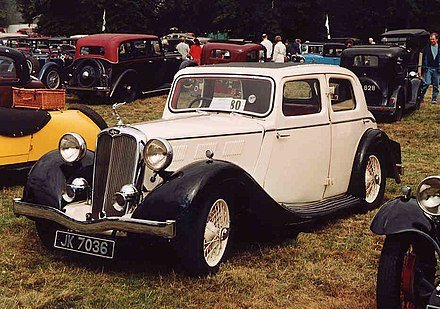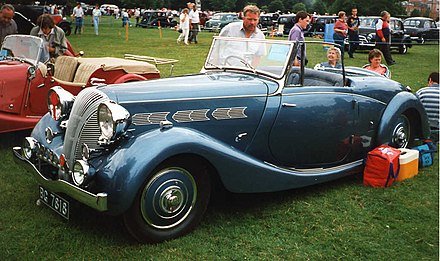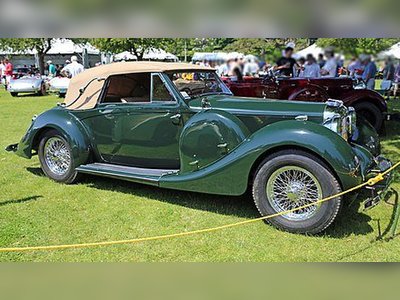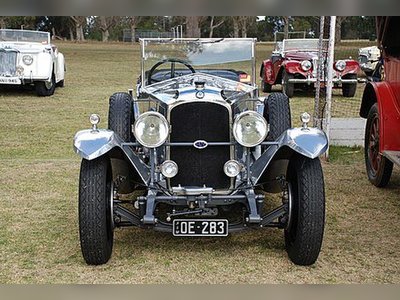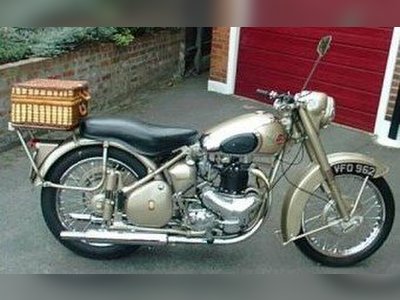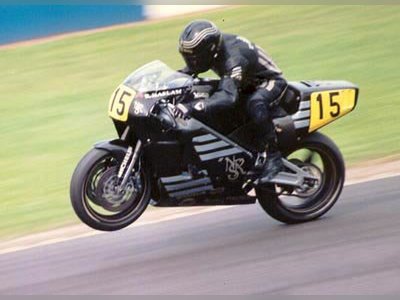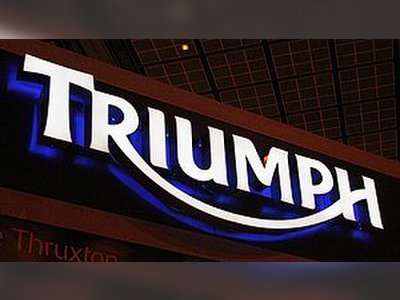British Heritage
Remember, Cherish, Learn.
beta
Triumph Motor Company
An Icon of British Heritage.
Born out of the industrial fervor of the 19th century, the Triumph Motor Company emerged as a beacon of British innovation and craftsmanship. Having produced an array of motorcycles and cars over the course of its existence, Triumph became an inseparable part of British heritage, a testament to the country's ability to manufacture vehicles of superior quality and enduring appeal. This article delves into the story of the Triumph Motor Company, the legacy it left behind, and its continuing influence on British culture and automotive design.
The Triumph marque, the symbol of this iconic British brand, can be traced back to 1885, when Siegfried Bettmann of Nuremberg established S. Bettmann & Co. in London. Initially, the company imported bicycles from Europe, selling them under Bettmann's trade name. It wasn't until the next year that the business adopted the Triumph brand, a decision that would lead to a century-long legacy.
Bettmann was later joined by Moritz Schulte in 1887, and the two German businessmen shifted their focus to producing bicycles in Coventry, England. In 1897, recognising the burgeoning trend towards motorised transportation, the company evolved into the Triumph Cycle Co. Ltd. By 1902, Triumph was manufacturing motorcycles on Much Park Street, Coventry, starting with engines purchased from other manufacturers. As their venture flourished, they quickly transitioned to producing their own engines, heralding the beginnings of a major player in the automotive industry.
During the First World War, the British Army placed substantial orders for the 550 cc Model H, bolstering Triumph's position as the leading manufacturer of motorcycles in Britain. By the 1920s, Triumph had ventured into car manufacturing, further expanding their influence on the British automotive scene.
The first car to bear the Triumph name was produced in 1923. As the company evolved, it became apparent that the Triumph name was particularly suited to sporting cars, while the Standard name, another brand under Triumph's umbrella, was reserved for saloons. This strategic decision was realised in 1953 with the launch of the Triumph TR2, the first model of the emblematic TR series of sports cars.
Triumph's growing success led to the acquisition by Leyland Motors in 1960, later becoming a part of the British Leyland (BL) conglomerate in 1968. Under the umbrella of British Leyland, the Triumph brand was incorporated into BL's Specialist Division, sitting alongside other esteemed British marques like Rover and Jaguar.
In the early 1950s, Triumph started making a name for itself in the world of sports cars with the introduction of the TR series, beginning with the TR2. The success of the TR series led to Triumph being viewed as a more marketable name than Standard, and the new car, introduced in 1959 as the Triumph Herald, solidified this transition.
Despite Triumph's successes, the brand was not immune to financial instability. In 1936, the Triumph bicycle and motorcycle divisions were sold off. Furthermore, the Second World War disrupted production, and the Coventry factory was destroyed in bombing raids in 1940.
Post-war, Triumph's fortunes began to improve. The remnants of the company were acquired by the Standard Motor Company in 1944, and car production was moved to Standard's factory at Canley, Coventry. Triumph's new owners had been supplying engines to Jaguar since 1938, and this relationship influenced Triumph's strategic direction. Triumph would subsequently compete directly with Jaguar by producing cars of a similar calibre, leading to the creation of a new range of Triumphs, starting with the Triumph Roadster.
The Triumph Motor Company faced numerous challenges throughout the 1970s, including reliability issues with some models and the complex corporate restructuring within the British Leyland conglomerate. Despite these difficulties, Triumph continued to introduce innovative models like the advanced Dolomite Sprint, a testament to the company's enduring commitment to design and engineering excellence.
The final car to carry the Triumph badge was the Acclaim, introduced in 1981 as a result of a collaboration with Honda. By 1984, the Triumph marque was retired and was later acquired by BMW as part of their purchase of the Rover Group in 1994.
Although the Triumph Motor Company's journey ended in the mid-1980s, its legacy endures. Today, Triumph remains an emblem of British heritage, an icon of a time when Britain was at the forefront of automotive innovation and design. The company's contribution to the automotive industry continues to be recognised, with classic Triumph models treasured by enthusiasts around the world. It's a legacy that not only speaks to the success of Triumph but also to the broader story of Britain's rich industrial history.
Origins and Establishment
The Triumph marque, the symbol of this iconic British brand, can be traced back to 1885, when Siegfried Bettmann of Nuremberg established S. Bettmann & Co. in London. Initially, the company imported bicycles from Europe, selling them under Bettmann's trade name. It wasn't until the next year that the business adopted the Triumph brand, a decision that would lead to a century-long legacy.
Bettmann was later joined by Moritz Schulte in 1887, and the two German businessmen shifted their focus to producing bicycles in Coventry, England. In 1897, recognising the burgeoning trend towards motorised transportation, the company evolved into the Triumph Cycle Co. Ltd. By 1902, Triumph was manufacturing motorcycles on Much Park Street, Coventry, starting with engines purchased from other manufacturers. As their venture flourished, they quickly transitioned to producing their own engines, heralding the beginnings of a major player in the automotive industry.
During the First World War, the British Army placed substantial orders for the 550 cc Model H, bolstering Triumph's position as the leading manufacturer of motorcycles in Britain. By the 1920s, Triumph had ventured into car manufacturing, further expanding their influence on the British automotive scene.
Triumph in the Automotive Industry
The first car to bear the Triumph name was produced in 1923. As the company evolved, it became apparent that the Triumph name was particularly suited to sporting cars, while the Standard name, another brand under Triumph's umbrella, was reserved for saloons. This strategic decision was realised in 1953 with the launch of the Triumph TR2, the first model of the emblematic TR series of sports cars.
Triumph's growing success led to the acquisition by Leyland Motors in 1960, later becoming a part of the British Leyland (BL) conglomerate in 1968. Under the umbrella of British Leyland, the Triumph brand was incorporated into BL's Specialist Division, sitting alongside other esteemed British marques like Rover and Jaguar.
Triumph's Golden Age and Challenges
In the early 1950s, Triumph started making a name for itself in the world of sports cars with the introduction of the TR series, beginning with the TR2. The success of the TR series led to Triumph being viewed as a more marketable name than Standard, and the new car, introduced in 1959 as the Triumph Herald, solidified this transition.
Despite Triumph's successes, the brand was not immune to financial instability. In 1936, the Triumph bicycle and motorcycle divisions were sold off. Furthermore, the Second World War disrupted production, and the Coventry factory was destroyed in bombing raids in 1940.
Post-war, Triumph's fortunes began to improve. The remnants of the company were acquired by the Standard Motor Company in 1944, and car production was moved to Standard's factory at Canley, Coventry. Triumph's new owners had been supplying engines to Jaguar since 1938, and this relationship influenced Triumph's strategic direction. Triumph would subsequently compete directly with Jaguar by producing cars of a similar calibre, leading to the creation of a new range of Triumphs, starting with the Triumph Roadster.
The Final Years and Legacy
The Triumph Motor Company faced numerous challenges throughout the 1970s, including reliability issues with some models and the complex corporate restructuring within the British Leyland conglomerate. Despite these difficulties, Triumph continued to introduce innovative models like the advanced Dolomite Sprint, a testament to the company's enduring commitment to design and engineering excellence.
The final car to carry the Triumph badge was the Acclaim, introduced in 1981 as a result of a collaboration with Honda. By 1984, the Triumph marque was retired and was later acquired by BMW as part of their purchase of the Rover Group in 1994.
Although the Triumph Motor Company's journey ended in the mid-1980s, its legacy endures. Today, Triumph remains an emblem of British heritage, an icon of a time when Britain was at the forefront of automotive innovation and design. The company's contribution to the automotive industry continues to be recognised, with classic Triumph models treasured by enthusiasts around the world. It's a legacy that not only speaks to the success of Triumph but also to the broader story of Britain's rich industrial history.
- Triumph Motor Companyen.wikipedia.org



